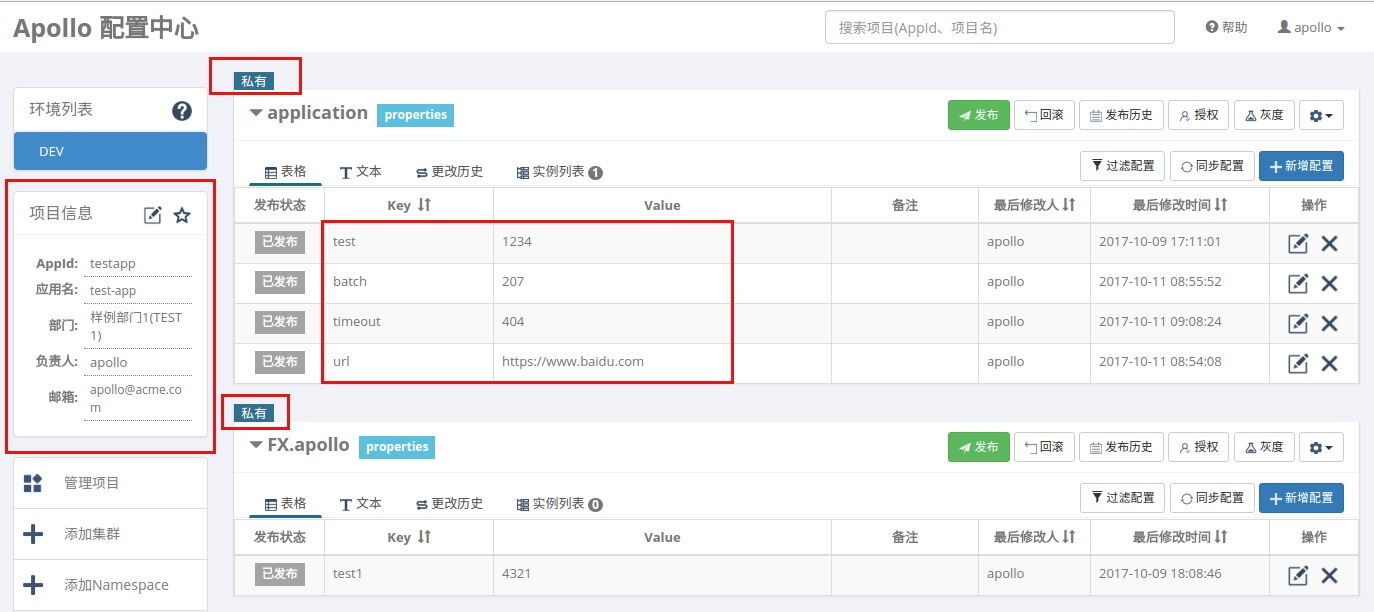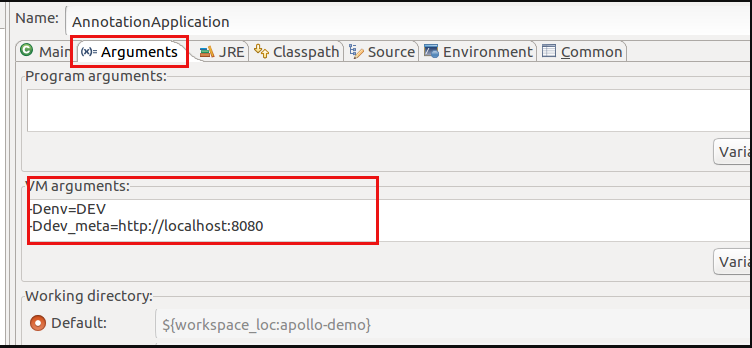前提:先搭建好本地的单机运行项目:http://www.cnblogs.com/EasonJim/p/7643630.html
说明:下面的示例是基于Spring Boot搭建的,对于Spring项目基本通用。迁移旧项目的配置下一篇说明,这里先就如何快速的集成Client和获取配置的值进行实践。
0、下面的示例都是基于官方提供的教程去实践的,可以参考如下网址:
1、先新建好Spring Boot项目,这里使用了Web做测试,所以引用了Thymeleaf模板。
搭建参考:http://www.cnblogs.com/EasonJim/p/7519854.html
2、登录Apollo上新建App和相关的配置项,可以参考如下配置:

3、在POM上引入Client的依赖,此时会有两个包引入Client和Core。
<dependency> <groupId>com.ctrip.framework.apollo</groupId> <artifactId>apollo-client</artifactId> <version>0.8.0</version> </dependency>
4、在项目上配置上面设置的app.id,注意此时是通过新建META-INF/app.properties文件实现的。

5、代码实现
实现的功能是通过配置中心修改后,再次刷新页面而不重启应用的情况下能看到值的改变。
实现方式主要几种在两种,1为通过API的形式增加监听回调函数来监听值的改变后直接修改,2为通过注入Bean的方式使用Bean下的专用监听注解实现回调监听。
5.1、通过API的方式
代码实现如下:
package com.jsoft.springboottest.springboottest1.controller; import org.slf4j.Logger; import org.slf4j.LoggerFactory; import org.springframework.beans.factory.annotation.Value; import org.springframework.stereotype.Controller; import org.springframework.ui.Model; import org.springframework.web.bind.annotation.RequestMapping; import org.springframework.web.bind.annotation.RequestMethod; import com.ctrip.framework.apollo.Config; import com.ctrip.framework.apollo.ConfigChangeListener; import com.ctrip.framework.apollo.ConfigService; import com.ctrip.framework.apollo.model.ConfigChange; import com.ctrip.framework.apollo.model.ConfigChangeEvent; import com.ctrip.framework.apollo.spring.annotation.EnableApolloConfig; @Controller public class IndexController { private static final Logger logger = LoggerFactory.getLogger(IndexController.class); private Config config; private int timeout; private int batch; private String url; @RequestMapping(value = "/index", method = RequestMethod.GET) public String index(Model model) { Entry entry = new Entry(); entry.setText("Text"); entry.setTitle("Title"); model.addAttribute("entries", entry); model.addAttribute("entry", new Entry()); model.addAttribute("url", url); model.addAttribute("timeout",timeout); model.addAttribute("batch",batch); logger.info("timeout:{}", timeout); logger.info("batch:{}", batch); logger.info("url:{}", url); return "index"; } public IndexController() { config = ConfigService.getAppConfig(); config.addChangeListener(new ConfigChangeListener() { @Override public void onChange(ConfigChangeEvent changeEvent) { logger.info("Changes for namespace {}", changeEvent.getNamespace()); for (String key : changeEvent.changedKeys()) { ConfigChange change = changeEvent.getChange(key); logger.info("Change - key: {}, oldValue: {}, newValue: {}, changeType: {}", change.getPropertyName(), change.getOldValue(), change.getNewValue(), change.getChangeType()); if (key.equals("url")) { url = change.getNewValue(); } if(key.equals("batch")) { batch = Integer.valueOf(change.getNewValue()); } if (key.equals("timeout")) { timeout = Integer.valueOf(change.getNewValue()); } } } }); } }
说明:
通过新建Config对象,使用的是ConfigService.getAppConfig()获取默认配置,也就是配置中心中的application.properties的,当然,getAppConfig可以指定不能的namespage。
通过获取Config对象增加监听回调函数addChangeListener。监听指定的值变化后,重新赋值变量。
这种方式应该是最简单的,不用写特殊的注解去实现,但是可能在运行时也会发现,程序在一启动时不会去获取默认的配置值,比如timeout这些是空的,要解决这个问题时需要在Class上增加@EnableApolloConfig的注解,然后在属性上增加@Value的值即可,改动如下:
package com.jsoft.springboottest.springboottest1.controller; import org.slf4j.Logger; import org.slf4j.LoggerFactory; import org.springframework.beans.factory.annotation.Value; import org.springframework.stereotype.Controller; import org.springframework.ui.Model; import org.springframework.web.bind.annotation.RequestMapping; import org.springframework.web.bind.annotation.RequestMethod; import com.ctrip.framework.apollo.Config; import com.ctrip.framework.apollo.ConfigChangeListener; import com.ctrip.framework.apollo.ConfigService; import com.ctrip.framework.apollo.model.ConfigChange; import com.ctrip.framework.apollo.model.ConfigChangeEvent; import com.ctrip.framework.apollo.spring.annotation.EnableApolloConfig; @Controller @EnableApolloConfig public class IndexController { private static final Logger logger = LoggerFactory.getLogger(IndexController.class); private Config config; @Value("${timeout:200}") private int timeout; @Value("${batch:200}") private int batch; @Value("${url:http://easonjim.com}") private String url; @RequestMapping(value = "/index", method = RequestMethod.GET) public String index(Model model) { Entry entry = new Entry(); entry.setText("Text"); entry.setTitle("Title"); model.addAttribute("entries", entry); model.addAttribute("entry", new Entry()); model.addAttribute("url", url); model.addAttribute("timeout",timeout); model.addAttribute("batch",batch); logger.info("timeout:{}", timeout); logger.info("batch:{}", batch); logger.info("url:{}", url); return "index"; } public IndexController() { config = ConfigService.getAppConfig(); config.addChangeListener(new ConfigChangeListener() { @Override public void onChange(ConfigChangeEvent changeEvent) { logger.info("Changes for namespace {}", changeEvent.getNamespace()); for (String key : changeEvent.changedKeys()) { ConfigChange change = changeEvent.getChange(key); logger.info("Change - key: {}, oldValue: {}, newValue: {}, changeType: {}", change.getPropertyName(), change.getOldValue(), change.getNewValue(), change.getChangeType()); if (key.equals("url")) { url = change.getNewValue(); } if(key.equals("batch")) { batch = Integer.valueOf(change.getNewValue()); } if (key.equals("timeout")) { timeout = Integer.valueOf(change.getNewValue()); } } } }); } }
说明:约定俗成,在@Value上获取值时记得增加默认值,以防止获取为空。
上面代码或许有些冗余,可以再提炼一下,因为config对象的值会实时更新,所以也不需要监听onChange事件,也不需要自己创建一个变量,最后代码实现如下:
package com.jsoft.springboottest.springboottest1.controller; import org.slf4j.Logger; import org.slf4j.LoggerFactory; import org.springframework.beans.factory.annotation.Value; import org.springframework.stereotype.Controller; import org.springframework.ui.Model; import org.springframework.web.bind.annotation.RequestMapping; import org.springframework.web.bind.annotation.RequestMethod; import com.ctrip.framework.apollo.Config; import com.ctrip.framework.apollo.ConfigChangeListener; import com.ctrip.framework.apollo.ConfigService; import com.ctrip.framework.apollo.model.ConfigChange; import com.ctrip.framework.apollo.model.ConfigChangeEvent; import com.ctrip.framework.apollo.spring.annotation.EnableApolloConfig; @Controller public class IndexController2 { private static final Logger logger = LoggerFactory.getLogger(IndexController2.class); private Config config = ConfigService.getAppConfig(); @RequestMapping(value = "/index2", method = RequestMethod.GET) public String index(Model model) { Entry entry = new Entry(); entry.setText("Text"); entry.setTitle("Title"); model.addAttribute("entries", entry); model.addAttribute("entry", new Entry()); model.addAttribute("url", config.getProperty("url", "")); model.addAttribute("timeout",config.getProperty("timeout", "")); model.addAttribute("batch",config.getProperty("batch", "")); logger.info("timeout:{}", config.getProperty("timeout", "")); logger.info("batch:{}", config.getProperty("batch", "")); logger.info("url:{}", config.getProperty("url", "")); return "index"; } }
5.2、通过注入Bean的方式
5.2.1、新建的Bean如下:
package com.jsoft.springboottest.springboottest1.controller; import com.ctrip.framework.apollo.Config; import com.ctrip.framework.apollo.model.ConfigChange; import com.ctrip.framework.apollo.model.ConfigChangeEvent; import com.ctrip.framework.apollo.spring.annotation.ApolloConfig; import com.ctrip.framework.apollo.spring.annotation.ApolloConfigChangeListener; import org.slf4j.Logger; import org.slf4j.LoggerFactory; import org.springframework.beans.factory.annotation.Value; import javax.annotation.PostConstruct; public class AnnotatedBean { private static final Logger logger = LoggerFactory.getLogger(AnnotatedBean.class); @Value("${timeout:200}") private int timeout; private int batch; @ApolloConfig private Config config; @ApolloConfig("FX.apollo") private Config anotherConfig; @PostConstruct void initialize() { logger.info("timeout is {}", timeout); logger.info("batch is {}", batch); logger.info("Keys for config: {}", config.getPropertyNames()); logger.info("Keys for anotherConfig: {}", anotherConfig.getPropertyNames()); } @Value("${batch:100}") public void setBatch(int batch) { this.batch = batch; } public int getBatch() { return batch; } public int getTimeout() { return timeout; } @ApolloConfigChangeListener("application") private void someChangeHandler(ConfigChangeEvent changeEvent) { logger.info("[someChangeHandler]Changes for namespace {}", changeEvent.getNamespace()); if (changeEvent.isChanged("timeout")) { refreshTimeout(); } if (changeEvent.isChanged("batch")) { setBatch(Integer.valueOf(changeEvent.getChange("batch").getNewValue())); } } @ApolloConfigChangeListener({ "application", "FX.apollo" }) private void anotherChangeHandler(ConfigChangeEvent changeEvent) { logger.info("[anotherChangeHandler]Changes for namespace {}", changeEvent.getNamespace()); for (String key : changeEvent.changedKeys()) { ConfigChange change = changeEvent.getChange(key); logger.info("[anotherChangeHandler]Change - key: {}, oldValue: {}, newValue: {}, changeType: {}", change.getPropertyName(), change.getOldValue(), change.getNewValue(), change.getChangeType()); } } private void refreshTimeout() { // do some custom logic to update placeholder value timeout = config.getIntProperty("timeout", timeout); logger.info("Refreshing timeout to {}", timeout); } }
5.2.2、通过@Configuration注入这个Bean,代码如下:
package com.jsoft.springboottest.springboottest1.controller; import org.springframework.context.annotation.Bean; import org.springframework.context.annotation.Configuration; import com.ctrip.framework.apollo.spring.annotation.EnableApolloConfig; @Configuration @EnableApolloConfig public class AnnotatedConfig { @Bean public AnnotatedBean annotatedBean() { return new AnnotatedBean(); } }
注意:要增加@EnableApolloConfig和@Configuration,不然不会生效。并且留意到@Bean的注解,如果没有这个时,@ApolloConfigChangeListener不会生效。这个是关键所在,@ApolloConfigChangeListener只能用于Bean注入上,这个和API的方式有明显区别。
在代码上使用:
package com.jsoft.springboottest.springboottest1.controller; import org.slf4j.Logger; import org.slf4j.LoggerFactory; import org.springframework.beans.factory.annotation.Autowired; import org.springframework.web.bind.annotation.RequestMapping; import org.springframework.web.bind.annotation.RestController; @RestController public class TestController { private static final Logger logger = LoggerFactory.getLogger(TestController.class); @Autowired private AnnotatedBean annotatedBean; @RequestMapping("/show") public String show(){ logger.info("batch:{}",annotatedBean.getBatch()); logger.info("timeout:{}",annotatedBean.getTimeout()); return "Hello World"+" batch:"+annotatedBean.getBatch()+" timeout:"+annotatedBean.getTimeout(); } }
说明:可以看出,只要@Autowired注入刚才的Bean就可以直接使用。
6、运行,一般只需要在/opt/settings/server.properties中配置了env=DEV就可以直接直接启动(因为Client在本地仓库的包上已经有了meta_server的信息),但是在IDE上也可以通过指定VM的参数,增加系统属性变量-D来实现调试,配置如下:

如果到处JAR运行,直接java -jar Spring-Boot-Demo.jar即可,不需要增加什么参数(但前提是配置了/opt/settings/server.properties的env的值)。
测试代码:https://github.com/easonjim/5_java_example/tree/master/apollotest/test1